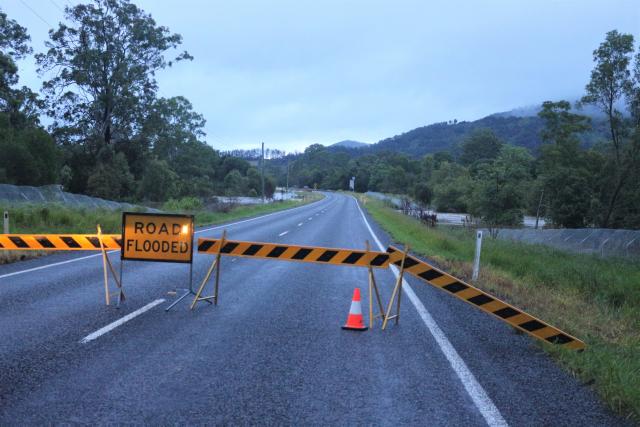
Historically, this time of year is the most dangerous time in Gympie for flooding to occur.
And that makes sense because summer is effectively our wet season.
With the recent rains and storms, it won’t take much for the river to rise and sudden deluges are likely to create flash flooding around the area.
Gympie has so many new residents in the area, and they may not know what to do in the event of a big water event.
So, here’s a handy checklist and a number of places to find reliable information in the event you become isolated in your home.
STEP 1 : Prepare an emergency kit.
Sometimes summer storms or flooding can mean we become isolated in our own homes for a couple of days.
When this occurs, it’s important to have a few essentials on hand to ride out the rough patch.
To survive, there are three things the human body needs – water, food, and oxygen.
Fortunately, during flooding events, oxygen is unlikely to be a priority unless you have a respiratory medical condition and require oxygen tanks to survive (and if so, make sure you have a spare).
So, food and clean drinking water become higher priorities.
Therefore, keep a supply of bottled water, enough for how many people there are in the household (and their pets) for several days.
Also keep on hand items like long-life milk, tins of baked beans or spaghetti, tins of fruit and vegetables, and other tinned items that are pre-cooked and therefore safe to eat cold.
Salada biscuits and other sealed crisp breads etc make excellent substitutes for bread in an emergency.
Also, ensure you have enough of your medications to last more than a week – so don’t wait until the last minute to refill your prescriptions.
Other good things to include in your kit are first aid provisions such as bandages, band-aids, aspirin or paracetamol, insect repellent, antiseptic cream (like Dettol or papaw ointment), eucalyptus oil, sunscreen, and aloe vera.
Your emergency kit should also include an AM/FM battery-operated radio, torches, matches, candles, dry blankets, spare batteries and perhaps colouring books and pencils, and a pack of cards to help keep you amused while you wait for the roads to reopen.
Consider having photocopies of your important documents in a water-proof box inside your kit, such as your insurance policies and birth and marriage certificates in the event your home is significantly damaged or destroyed.
STEP 2: Pay attention to warnings
When it comes to advance warnings, err on the side of caution, because it would be better to be a false alarm than a full-blown disaster that you weren’t prepared for.
Therefore, consider opting in to the Gympie Regional Council’s Disaster Dashboard emergency alert service.
The service will issue an SMS to all the registered mobile phones in an area that is likely to be impacted by a severe weather event, once an alert is issued by the Bureau of Meteorology.
You can opt in at the council’s website.
However, if you’re not online you can call into any of the Gympie region libraries and the library staff can step you through registering for the alerts and you can also call the council on 1300 307 800 to give your permission and they can register you for SMS in that way.
Other ways you can get notified there is a severe weather warning is to pay attention to television or radio news.
For those online, there are a number of really helpful sites including the River Height Chart on the BOM website, the RACQ road conditions website and the Gympie Regional Council’s Disaster Dashboard.
Don’t rely on Facebook for your information and if you ask questions on community sites, you’ll just be feeding the trolls.
STEP 3: Seek help
The important thing to remember in the event of a severe weather event is there are emergency services and people to help you if things go really sideways.
In a life-threatening emergency, call 000.
If you need help to secure your property because of damage, contact the State Emergency Service on 132 500.
In the event of downed power-lines, do not approach and keep other people clear and call Energex immediately on 13 19 62.
IMPORTANT FACTS:
Power outages will frequently occur so having a battery charger for your mobile phone is a good idea in the event you have to contact someone in an emergency.
Never wade into, swim or drive into flood waters or storm water run-off because it can contain pollutants and dangerous chemicals, raw sewerage, bacteria, snakes and other venomous creatures or create strong currents when teamed with debris and hidden dangers can drown you.
Use extreme caution when driving at night in the rain on back roads, because water over the road may be difficult to spot until you are right on top of it. If possible, avoid driving during those conditions altogether.
Listen to your neighbours and long-term residents of the community if they say you or your property may be adversely affected by severe weather, because chances are, if it’s happened before, it will happen again.
Gympie Regional Council generally closes the following bridges when the river height of the Mary River at Gympie Weir reaches the following bridge heights – be prepared that they will be closed earlier than these heights.
* Kidd Bridge – 9.90m
* Inglewood Bridge – 13.4m
* Bells Bridge – 13.5m
* Normanby Bridge (south end) – 15.54m
* Pengellys Bridge – 15.85m
* Six Mile Bridge – 17m





